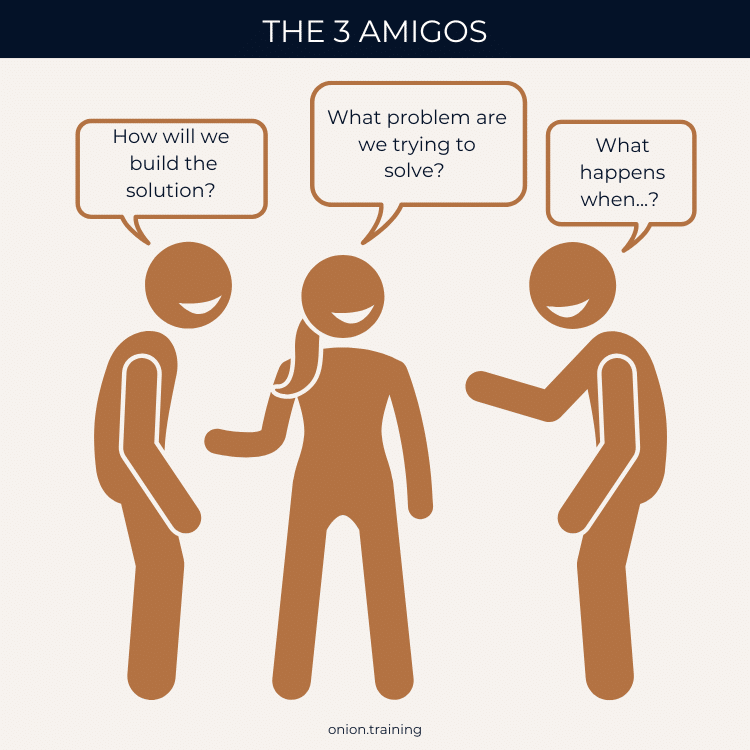In Agile software development, effective communication and teamwork are crucial for project success. One powerful technique that has gained popularity in recent years is the “Three Amigos” approach. This technique brings together important viewpoints to ensure a shared understanding of project requirements, development processes and quality assurance.
Table Of Contents
What are the Three Amigos?
The Three Amigos refer to a collaborative meeting that brings together three essential roles in software development: the Business Analyst (or Product Owner), the Developer and the Quality Assurance (QA) Tester. The purpose of this meeting is to examine an increment of work from different viewpoints before, during and after development.
The primary objectives of a Three Amigos meeting are:
- To clarify and refine business requirements
- To discuss development approaches and potential challenges
- To identify test scenarios and quality criteria
By combining these viewpoints, teams can bridge gaps in understanding, reduce ambiguity and ensure a common vision for the project deliverables.
The Three Roles and Their Contributions
Business Analyst / Product Owner
The Business Analyst or Product Owner represents the business perspective and is responsible for detailing the business requirements. Their role includes:
- Introducing user stories and acceptance criteria
- Clarifying the problem the team is trying to solve
- Ensuring alignment with overall business goals and customer expectations
- Collecting feedback and refining requirements based on team input
Developer
The Developer brings a technical perspective to the meeting. Their contributions include:
- Discussing the architecture and low-level design
- Assessing the feasibility of requirements
- Proposing potential solutions and features
- Identifying technical challenges and constraints

Quality Assurance Tester
The QA Tester focuses on the quality and testing aspects of the project. Their responsibilities in the meeting are:
- Presenting test cases and scenarios
- Identifying edge cases and potential issues
- Ensuring all acceptance criteria are covered by test cases
- Discussing non-functional requirements and quality standards
Benefits of the Three Amigos Approach
Implementing the Three Amigos strategy in your Agile development process can yield numerous benefits:
- Improved Communication: By bringing together different perspectives, the Three Amigos approach fosters better communication between disciplines and promotes a shared understanding of project goals.
- Early Issue Detection: Potential problems, misunderstandings and ambiguities are identified and addressed early in the development process, reducing the likelihood of costly rework later.
- Enhanced Quality: With QA involvement from the start, testing considerations are built into requirements and development plans, leading to higher quality outcomes.
- Increased Efficiency: By aligning expectations and clarifying requirements upfront, teams can work more efficiently and reduce time spent on unnecessary features or misguided development efforts.
- Better Risk Management: The diverse perspectives help identify potential risks and challenges early, allowing for proactive mitigation strategies.
Implementing Three Amigos Meetings
To successfully implement Three Amigos meetings in your Agile process, consider the following best practices:
Timing and Frequency
Try to schedule Three Amigos meetings two or three sprints before development starts. This will allow for thorough discussions and refinements of requirements without delaying the development process. The frequency of meetings can vary based on project needs, but they should be held regularly to maintain alignment across the project deliverables.
Meeting Duration
Keep Three Amigos meetings concise and focused. Aim for a duration between 30 minutes to 1 hour. Longer meetings can lead to decrease in effectiveness and engagement.
Preparation
Invest time in preparation to get the most out of meeting productivity. Create a checklist to gauge the readiness of user stories and ensure all participants come prepared with relevant information and questions.
Flexibility in Participation
Though the core participants are the Business Analyst, Developer and QA Tester, be open to including additional perspectives when necessary. Designers, subject matter experts, or other stakeholders may be invited to contribute their insights on specific topics.
Focus on Collaboration
Encourage open dialogue and active participation from all attendees. The goal is to reach an agreement on requirements, development approaches and testing strategies through collaborative discussion.

The Three Amigos Process
A typical Three Amigos meeting follows this general structure:
- Introduction: The Business Analyst presents the user story and acceptance criteria.
- Requirement Clarification: Team members ask questions and provide feedback on the requirements.
- Test Case Review: The QA Tester presents proposed test cases and scenarios. The team discusses and refines these, identifying any missed edge cases.
- Development Planning: The Developer shares their understanding of the requirements and outlines the proposed implementation approach.
- Consensus Building: The team works together to address any discrepancies, clarify ambiguities and reach a shared understanding of the work to be done.
- Action Items: Any necessary updates to requirements, test cases, or development plans are noted and assigned.
Challenges and Solutions
While the Three Amigos approach offers many benefits, teams may encounter some challenges:
- Time Constraints: In fast-paced environments, finding time for regular meetings can be difficult. Solution: Schedule Three Amigos sessions as part of your sprint planning routine and keep them focused and efficient.
- Dominant Personalities: Sometimes, one perspective may overshadow others. Solution: Encourage equal participation and use facilitation techniques to ensure all voices are heard.
- Scope Creep: Discussions may lead to expanding requirements. Solution: Stay focused on the core user story and use a separate backlog refinement process for new ideas.
- Overreliance on Meetings: Teams may become too dependent on these meetings for all decision-making. Solution: Use Three Amigos for key discussions, but encourage ongoing collaboration outside of formal sessions.
Implementing Three Amigos meetings requires commitment and practice, but the benefits in terms of reduced misunderstandings, improved quality and increased team alignment make it a valuable investment. As with any Agile practice, be prepared to adapt and refine your approach based on your team’s unique needs and experiences.
The Three Amigos method helps bridge the gap between business expectations and technical realities, ultimately leading to more successful software development outcomes. Embrace this approach and watch your team’s ability to deliver value sprint after sprint.
Related Articles
Beyond Bug Hunters: The Evolving Role of Software Testers

